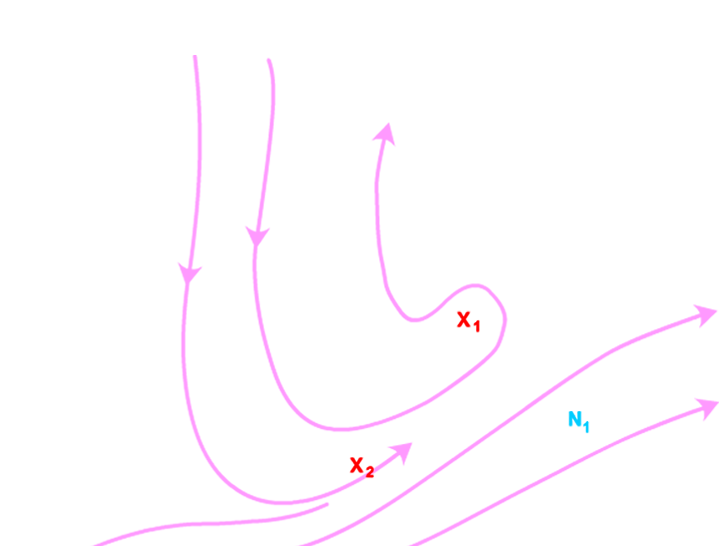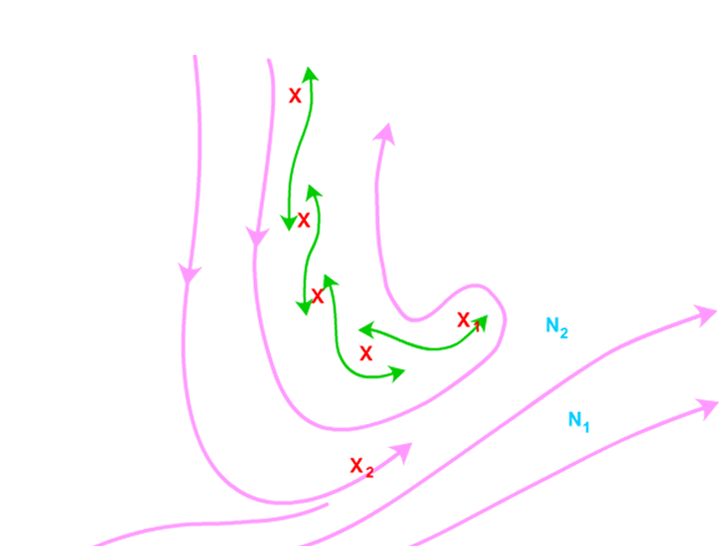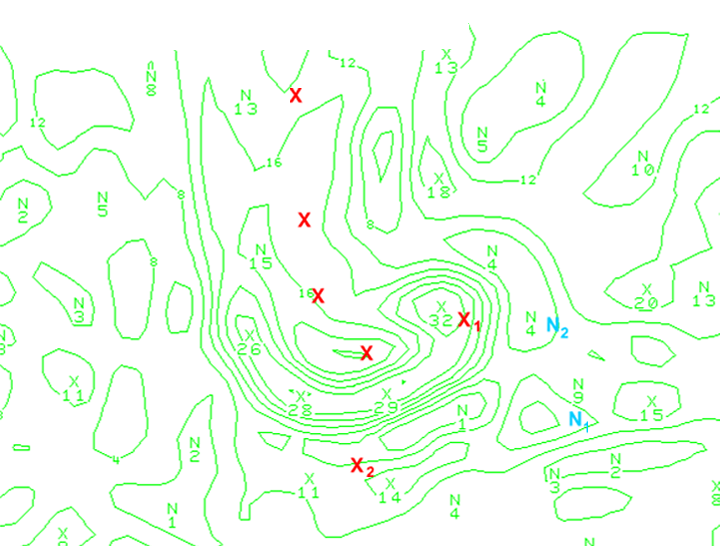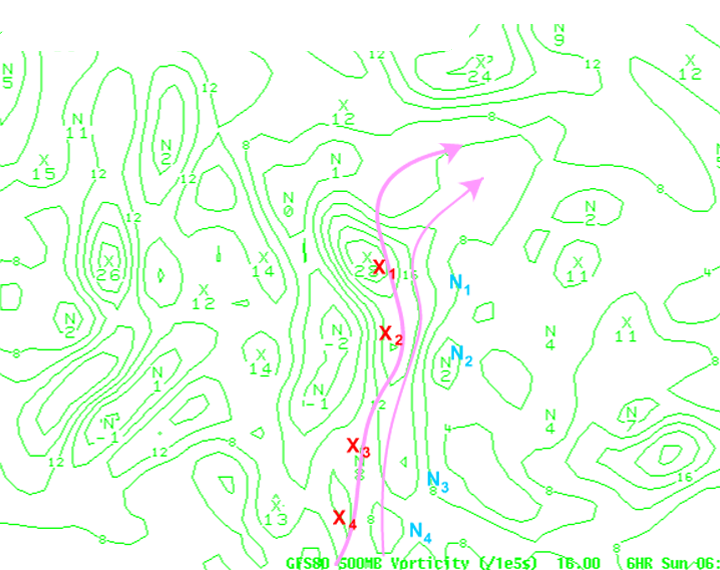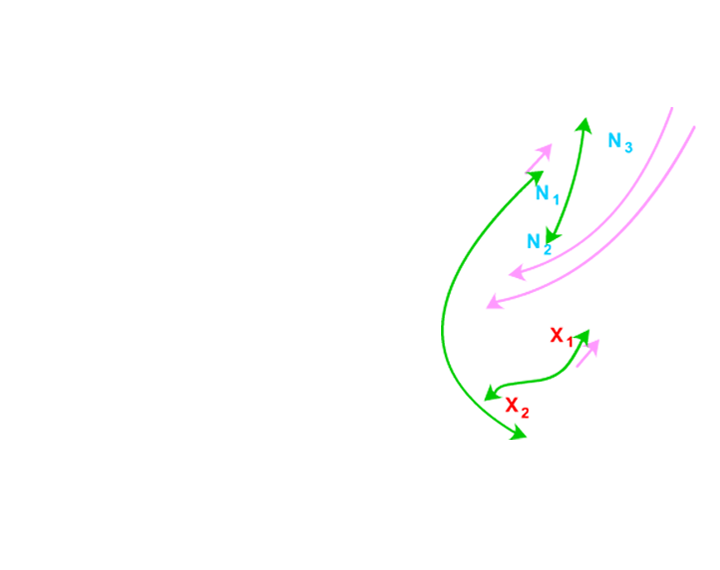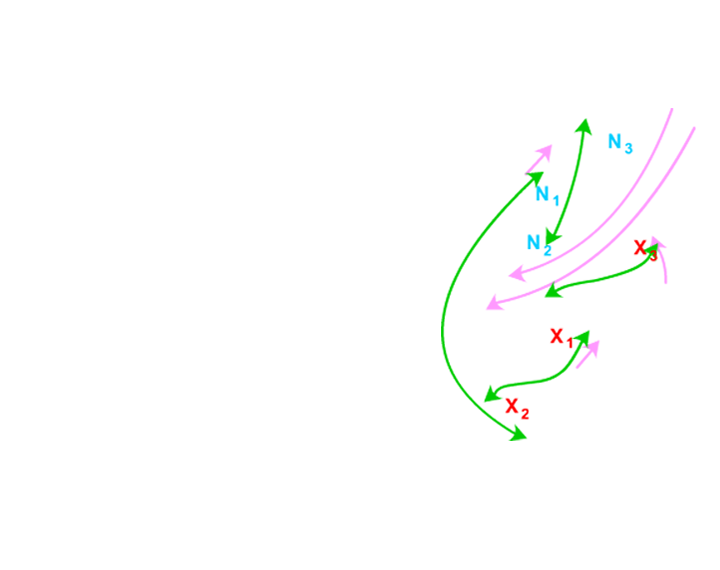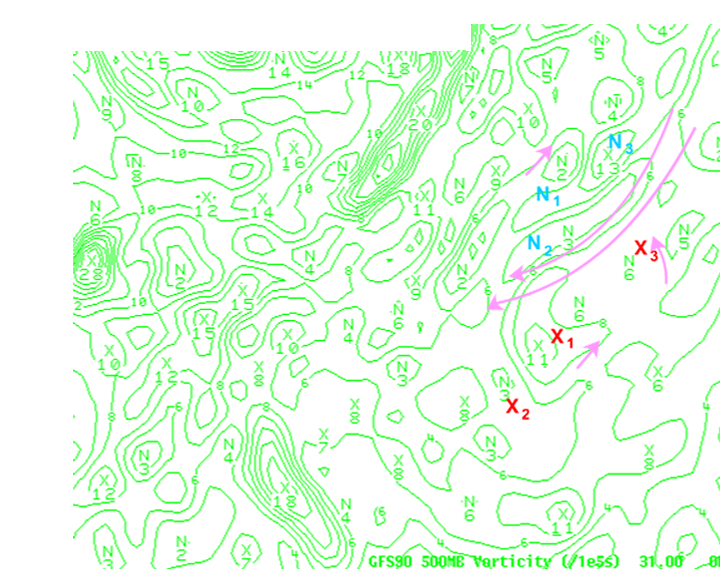Overview
Vorticity Maxima and Comma Patterns
Season: Every day
Phenomena: Moist Circulations, Vorticity Maxima and Vorticity Advection
Tools: GOES water vapour
Forecast Challenges:
- Identify and predict the vorticity maxima in order to predict areas of positive vorticity advection
- Identify the related axes of maximum winds, deformation zones and air masses
Vorticity maxima signatures are very common and indicate areas of ascending circulation and atmospheric forcing. The correct placement of vorticity maxima is vital to the placement of related dynamic features such as the axis of maximum winds and deformation zones.
Note: All examples and conceptual models in this module are set in the northern hemisphere. All graphics are oriented north to south with north on top.
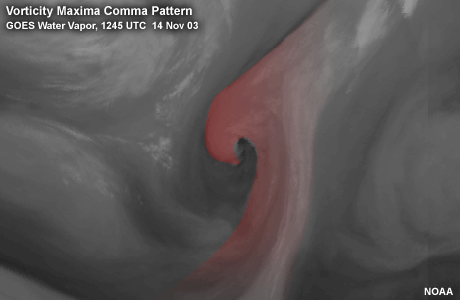
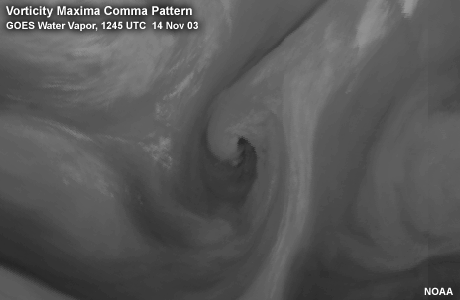
Conceptual Model
Development of a Comma Pattern
The shape of the cyclonic comma pattern reveals the location of the vorticity maximum. The vorticity maximum is located at the point of inflection and is the center of the cloud rotation in the atmospheric frame of reference. The shape of the concave inflow and convex outflow arcs are related to both the relative intensity of the vorticity maximum and the length of time the vorticity maximum has been acting on these arcs. The concave arc becomes more "caved" with both vorticity maximum intensity and age. The convex arc becomes more vexed.
The vorticity maximum (X) is the addition of both horizontal wind shear (S) (simply referred to as shear hereafter) and rotational vorticity (R). The following graphics illustrate the concept. The size of the symbols indicates relative intensity.
Given pure rotation, this conceptual cloud line will evolve in a symmetrical fashion. The position of the vorticity maximum is at the center of the rotation, which is also the point of inflection. The rotational vorticity is the sole component of vorticity. There is no shear vorticity component. The shape of the comma is determined by both the intensity of the vorticity maximum and its age.
With increased shear on the equatorial side of the rotation, the point of inflection and the total vorticity is shifted towards that region of greater shear. The concave arc in the location of the wind maximum is enhanced. The convex arc is not enhanced and is created purely by the rotational component of the vorticity, which remains unchanged and located at the center of the circle. The point of inflection is still the center of moisture rotation, which is also the location of the total vorticity maximum resulting from the sum of the rotational and shear vorticities.
To summarize, this point of inflection is a cyclonic outward cusp formed by the intersection of two cyclonically curved arcs directed toward the cusp. Typically, a cyclonic outward cusp is created by westerly speed shear that is equatorward of the cusp and marks the location of a vorticity maximum. This pattern is very common due to the prevailing westerly circulations around the globe.
With even stronger winds the equatorial shear component of the vorticity increases and there is more displacement of the total vorticity and point of inflection toward the region of shear and away from the position of the rotational vorticity centre. The concave arc in the location of the wind maximum is really enhanced. And again, with increased shear vorticity, the vorticity maximum will be more intense.
If the shear is on the poleward side of the rotation, the same shifting of the point of inflection takes place, again with the center of total vorticity shifting towards the region of shear. In contrast, however, the convex arc in the location of the wind maximum is enhanced. The concave arc is not enhanced and is created purely by the rotational component of the vorticity, which remains unchanged and located at the center of the circle. The vorticity maximum will be buried within the moisture area as opposed to the previous illustrations, where it is located in the dry portion of the circulation. This enhancing of the convex arc is "vexing" in that the point of inflection and vorticity maximum may be more difficult to locate than when the vorticity is dominated by its rotational component or the shear is equatorward of the rotational center.
Poleward shear comma clouds are common with the northeast trade winds in the tropics.
To summarize, this point of inflection is a cyclonic inward cusp formed by the intersection of two cyclonically curved arcs directed toward the cusp. Typically, a cyclonic inward cusp is created by easterly speed shear that is poleward of the cusp and marks the location of a vorticity maximum.
It's important to note that in this idealized example the moisture extends into the vorticity centre. In the real atmosphere the moisture may dry out near the circulation centre, especially as the circulation ages. As a result, the actual point of inflection may be displaced upstream from the apparent point of inflection revealed by the moisture patterns.
Morphology of a Comma Pattern
Roger Weldon originally identified the "comma" cloud pattern in the early 1980's. The cloud and absolute vorticity isopleth correlations he used were empirical. Variation in cloud heights from 500 hPa and time differences between the analysis and the satellite data can lead to errors. However, the centre of cloud rotation as identified by the point of inflection is the vorticity maximum.
Comma Dominated by Rotation and/or Equatorial Shear
The concave arc associated with the axis of maximum winds defines this type of comma. The most concave portion of the comma pattern identifies where the axis of maximum winds crosses into the moisture area.

The comma head is the portion of the comma downstream from the vorticity maximum. Positive vorticity advection will be strongest in the comma head region.
Comma Dominated by Poleward Shear
The convex arc defines this type of comma. The concave arc region is minimal, and the point of inflection is buried within the moisture area. The comma head is still that portion of the comma downstream from the vorticity maximum.
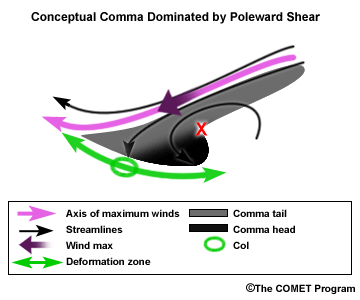
Other Considerations
- With both patterns, the comma tail is associated with the warm conveyor belt. Vorticity advection will be minimal in this region. The comma tail begins at the upstream long wave trof.
- It is very important to remember that all satellite features are generated by system-relative motions.
- If moisture elements on the poleward side of the cyclonic circulation are stationary or moving westward with respect to the earth's surface, the vorticity maximum is actually a closed upper low.
Analysis
In the following interaction, first take a look at the GOES water vapor loop, then analyze it for the axes of maximum winds, vorticity maxima, and vorticity minima. After identifying these features, compare your analysis to the one provided.
Satellite Loop
Within this GOES 4-km water vapor loop, look for the the development of a vorticity maximum.
After viewing the loop, click the Your Analysis tab to access the last image of the loop (1430 UTC) and mark the location of the vorticity maxima, any associated vorticity minima, and any axes of maximum winds.
Your Analysis
The following exercise cannot be completed in Internet Explorer 11 or older versions. Please use Microsoft Edge or other modern browsers to complete this exercise.
Mark the location of the most prominent vorticity maxima, vorticity minima, and axes of maximum winds within the highlighted area.
Click the Done button to compare your analysis to the "Expert's Analysis".

Draggable Elements:
Vorticity minima:
Vorticity maxima:
| Tool: | Tool Size: | Color: |
|---|---|---|
|
|
|
Interpretation
Let's take a closer look at this situation. First we'll look at the large-scale atmospheric circulations, then we'll focus on the main comma and vorticity maximum, and finally, we'll take a closer look at the moisture patterns associated with much more subtle commas.
Circulation Overview
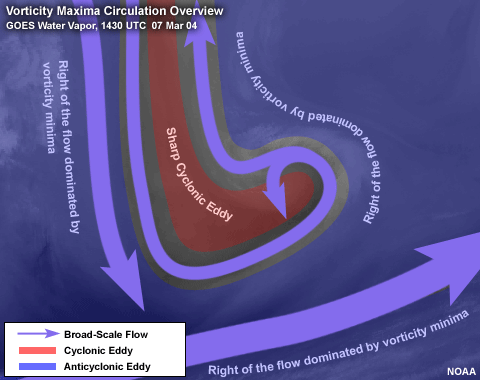
A broad and strong northerly flow spilling over the top of a large upper ridge to the west digs ever more southward during the animation time period. This flow turns sharply northward again climbing over a downstream ridge. A broad southwesterly upper flow crosses the southern portions of the satellite view. Both of these circulations contribute to spin up the central vorticity maximum as it translates eastward. Near the end of the animation, moisture elements poleward of the vorticity maximum are stationary in the earth frame of reference. When this occurs, the vorticity maximum graduates to an upper low. The satellite image is dominated by upper ridges in regions to the right of the axes of maximum winds. The vorticity maximum is caged within the sharp and deep cyclonic eddy.
The Comma
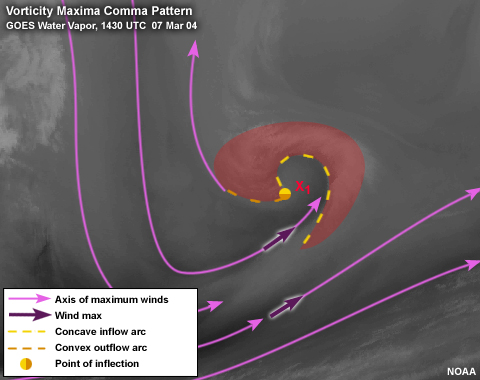
Let's focus in on the largest comma. Some key points here are:
- The dominant vorticity maximum is to the left of the associated flow looking downstream. The associated wind maximum can be seen as darkening in the dry surge of the comma pattern.
- The point of inflection and the vorticity maximum is located at the cusp of the moisture pattern as this vorticity maximum is dominated by rotation and equatorward shear. Of these two components, rotation is by far the largest contributor to the total vorticity.
- The point of inflection has already completed a cyclonic rotation of 270 degrees. Obvious rotation around the centre of cloud rotation as seen here can be the result of a strong vorticity centre, an older vorticity centre, or a combination of both.
Moisture Patterns

From a moisture edge perspective, in order to identify the vorticity maximum, you are typically interested in the concave or inflow arc of the cyclonic pattern.
X1
This comma pattern evolves into a strongly wrapped pattern. The sharp curvature of the axis of maximum winds wrapping around the vorticity maximum means that curvature vorticity is the main contributor to the strong vorticity maximum. Darkening in the surge area is associated with a wind maximum that will increase the vorticity of this centre even more.
X2
An axis of maximum winds carves a more southerly path into the base of the upper trof. The dry surge in the moisture edge is the evidence required to locate the new vorticity minimum at the cusp in the comma pattern.
N1 and N2
These anticommas are dominated by poleward shear. As a result, the centre of cloud rotation must be located at the interior point of inflection of the moisture signature.
The Vorticity Maxima Chain
Moisture edges related to deformation zones can also be used very effectively to infer subtle vorticity maxima. The characteristic "backward S" deformation zones can only be created by two vorticity maxima located at both ends of the moisture edge. A series of these subtle "backward S's" can be seen along a north-to-south line just to the west of the comma head. The points of inflection of each comma pattern are much more subtle than the deformation zones that reveal the weak cyclonic circulations.
Comparison with NWP
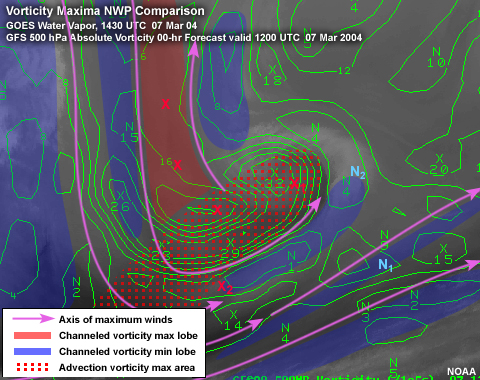
The NWP and observed vorticity centres X1, N1, and N2 correspond well. The NWP has identified a strong (32) vorticity maximum correlated with X1, but has misplaced it to the northwest. Both N1 and N2 are similarly displaced. These placement errors could be important for mesoscale applications.
The weakest part of the NWP solution is in the orientation of the axes of maximum winds spilling over the upper ridge. Using the WV imagery, two distinct and separate axes of maximum winds can be identified as comprising the broad flow. An edge of higher and colder cirrus cloud just east of the ridge can be used to locate a secondary axis of maximum winds. This particular wind axis can be followed along the cirrus edge into the trough, where it digs southeastward and spins up a new vorticity maximum.
In order to diagnose the NWP deficiencies in identifying the upper flow, it is easiest to consider channeled and advection flows.
- A channeled flow is straight. An elongated lobe of vorticity maxima will lie to the left of the flow, while an elongated lobe of vorticity minima will lie to the right of the flow looking downstream. Vorticity advection along a channeled flow is weak.
- An advection flow is curved. Curved flows typically advect significant
amounts of vorticity.
- If the flow curves cyclonically, the vorticity maximum is enhanced. The vorticity maximum area to the left of the cyclonically curved flow transforms into a more intense positive vorticity centre. Significant positive vorticity advection occurs downstream from this intense positive vorticity centre. The lobe of vorticity minima to the right of the flow weakens and is typically replaced by a short-wave trough as the flow becomes more cyclonically curved.
- If the flow turns anticyclonically, the vorticity minimum is enhanced. The vorticity minimum lobe to the right of the anticyclonically curved flow transforms into a more intense negative vorticity centre. Significant negative vorticity advection occurs downstream from this intense negative vorticity centre. The lobe of vorticity maxima to the left of the flow weakens and is typically replaced by a short-wave ridge as the flow becomes more anticyclonically curved.
In the accompanying graphic, red and blue shaded lobes of channeled vorticity straddle the axes of maximum winds identified from WV imagery. The orientation of the NWP vorticity lobes is more northwesterly compared to the northerly orientation of the axes of maximum winds identified from WV imagery. The red stippling is used to identify an area of significant cyclonic curvature and positive vorticity advection (PVA).
Implications
The correct placement of vorticity maxima is vital to the placement of related dynamic features such as the axis of maximum winds and deformation zones. All of these dynamic features must fit cohesively into the atmospheric puzzle. The correct placement of a vorticity maximum might be the piece of the puzzle required to correctly identify and place other dynamic features.
Here are some important attributes of vorticity maxima to keep in mind when identifying them:
- Circulations around vorticity maxima are typically strong. As a result, numerical analyses of the atmosphere are typically successful in their placement and appropriate relative intensity. However, if numerical analyses should misplace or not analyze a vorticity maximum, the implications on the predictions could be important.
- Cyclonic circulations tend to be rather moist.
- Correctly identifying and locating vorticity maxima can help better predict convection and cloud patterns.
- Convective feedback in numerical models can generate spurious vorticity maxima that can be identified as inappropriate through a careful analysis of the WV imagery.
Examples
Example 1: Pure Rotation
Here are a few examples of vorticity maxima. As is often true on the forecast desk, cases are not always as straight forward as the conceptual models. These real-world cases may not be the best examples of vorticity minima, but then how often do you see any perfect examples at the desk.
Carefully examine the loop before doing the analysis. Be sure to compare your analysis to the ones provided.
Satellite Loop
Within this GOES 4-km water vapor loop, look for the the development of a vorticity maximum dominated by rotation.
After viewing the loop, click the Your Analysis tab to access the last image of the loop (1245 UTC) and mark the location of the vorticity maxima, any associated vorticity minima, and any axes of maximum winds.
Your Analysis
The following exercise cannot be completed in Internet Explorer 11 or older versions. Please use Microsoft Edge or other modern browsers to complete this exercise.
Mark the location of the most prominent vorticity maxima, vorticity minima, and axes of maximum winds within the highlighted area.
Click the Done button to compare your analysis to the "Expert's Analysis".

Draggable Elements:
Vorticity minima:
Vorticity maxima:
| Tool: | Tool Size: | Color: |
|---|---|---|
|
|
|
Example 2: Equatorial Shear
Carefully examine the loop before doing the analysis. Be sure to compare your analysis to the ones provided.
Satellite Loop
Within this GOES 4-km water vapor loop, look for the the development of a vorticity maximum with equatorial shear.
After viewing the loop, click the Your Analysis tab to access the last image of the loop (0600 UTC) and mark the location of the vorticity maxima, any associated vorticity minima, and any axes of maximum winds.
Your Analysis
The following exercise cannot be completed in Internet Explorer 11 or older versions. Please use Microsoft Edge or other modern browsers to complete this exercise.
Mark the location of the most prominent vorticity maxima, vorticity minima, and axes of maximum winds within the highlighted area.
Click the Done button to compare your analysis to the "Expert's Analysis".
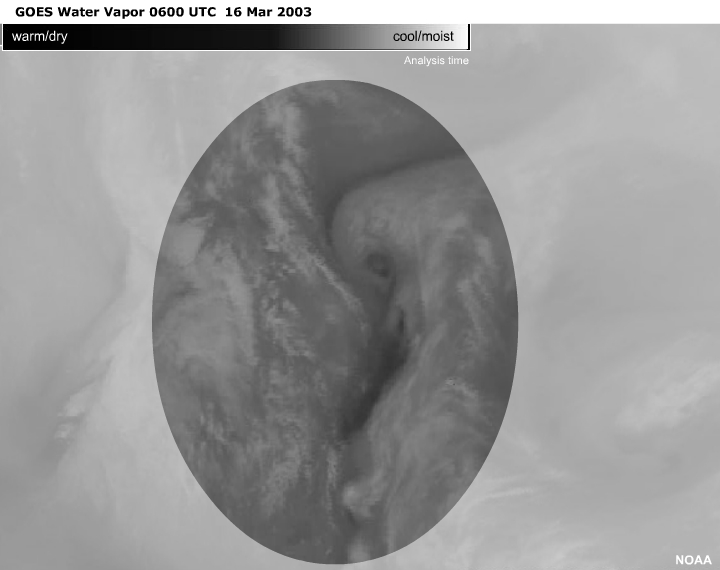
Draggable Elements:
Vorticity minima:
Vorticity maxima:
| Tool: | Tool Size: | Color: |
|---|---|---|
|
|
|
Example 3: Poleward Shear
Carefully examine the loop before doing the analysis. Be sure to compare your analysis to the ones provided.
Satellite Loop
Within this GOES 4-km water vapor loop, look for the the development of a vorticity maximum with poleward shear.
After viewing the loop, click the Your Analysis tab to access the last image of the loop (0115 UTC) and mark the location of the vorticity maxima, any associated vorticity minima, and any axes of maximum winds.
Your Analysis
The following exercise cannot be completed in Internet Explorer 11 or older versions. Please use Microsoft Edge or other modern browsers to complete this exercise.
Mark the location of the most prominent vorticity maxima, vorticity minima, and axes of maximum winds within the highlighted area.
Click the Done button to compare your analysis to the "Expert's Analysis".

Draggable Elements:
Vorticity minima:
Vorticity maxima:
| Tool: | Tool Size: | Color: |
|---|---|---|
|
|
|
This concludes Vorticity Maxima and Comma Patterns, please take a few minutes to take the Quiz, and then fill out our User Survey.
Contributors
Comet Sponsors
- National Oceanic and Atmospheric Administration (NOAA)
- National Weather Service (NWS)
- Naval Meteorology and Oceanography Command (NMOC)
- Air Force Weather Agency (AFWA)
- National Environmental Satellite Data and Information Service (NESDIS)
- Environment Canada - Meteorological Service of Canada (MSC)
- Australian Bureau of Meteorology (BoM)
Principal Science Advisor
- Phil Chadwick — MSC
Project Lead
- Bruce Muller — UCAR/COMET
Instructional Design
- Bruce Muller — UCAR/COMET
Computer Graphics/Interface Design
- Steve Deyo — UCAR/COMET
- Heidi Godsil — UCAR/COMET
Multimedia Anchoring
- Bruce Muller — UCAR/COMET
- Dan Riter — UCAR/COMET
Data Provided by
- NWS - NOAA
COMET HTML Integration Team 2019
- Tim Alberta — Project Manager
- Dolores Kiessling — Project Lead
- Steve Deyo — Graphic Artist
- Jordan Goodridge — Student Assistant/Web Developer
- Gary Pacheco — Lead Web Developer
- David Russi — Translations
- Gretchen Williams — Web Developer
- Alex Sheehan — Web Developer
- Tyler Winstead — Web Developer
COMET Staff
Director
- Dr. Timothy Spangler
Deputy Director
- Dr. Joe Lamos
Business Manager/Supervisor of Administration
- Elizabeth Lessard
Administration
- Lorrie Alberta
- Linda Korsgaard
- David Russi
- Bonnie Slagel
Graphics/Media Production
- Steve Deyo
- Heidi Godsil
- Seth Lamos
Hardware/Software Support and Programming
- Tim Alberta (IT Manager)
- James Hamm
- Karl Hanzel
- Ken Kim
- Mark Mulholland
- Dan Riter
- Carl Whitehurst
- Malte Winkler (student)
Instructional Design
- Patrick Parrish (Production Manager)
- Dr. Alan Bol
- Lon Goldstein
- Dr. Vickie Johnson
- Bruce Muller
- Dwight Owens
- Dr. Sherwood Wang
Meteorologists
- Dr. Greg Byrd (Project Cluster Manager)
- Wendy Schreiber-Abshire (Project Cluster Manager)
- Dr. William Bua
- Patrick Dills
- Tom Dulong
- Dr. Stephen Jascourt
- Matthew Kelsch
- Dolores Kiessling
- Dr. Arlene Laing
- Elizabeth Mulvihill Page
- Dr. Doug Wesley
Software Testing/Quality Assurance/Copyrights Administration
- Michael Smith (Coordinator)
NOAA/National Weather Service - Forecast Decision Training Branch
- Anthony Mostek (NWS COMET Branch Chief [acting] and Satellite Training Leader)
- Dr. Richard Koehler (Hydrology Training Lead)
- Brian Motta (IFPS Training)
- Dr. Robert Rozumalski (SOO Science and Training Resource [SOO/STRC] Coordinator)
- Shannon White (AWIPS Training)
Meteorological Service of Canada Visiting Meteorologists
- Phil Chadwick
- James Cummine


